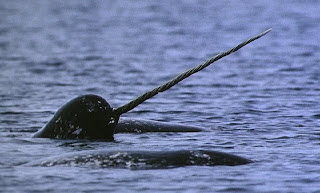
A small pod of narwhals, Monodon Monoceros
For centuries, humans have speculated on narwhals' bizarre horns, believing them to be everything from supernatural appendages to spear fishing weapons to tools for poking around on the ocean floor. In 2005 a team from Harvard and the National Institute of Standards and Technology put a horn under an electron microscope and discovered that it was actually covered in nerve endings, more than 10 million total, tunneling from the center of the horn to the outer surface. As it seems, the horn is a highly advanced, completely unique sense organ, probably used to detect subtle changes in the narwhals' surroundings.
"This whale is intent on understanding its environment," said Martin T. Nweeia, the team's leader and a clinical instructor at the Harvard School of Dental Medicine, "...The tusk is not about guys duking it out with sticks and swords."
In Inuktitut (Eskimo), narwhals are called Qilalugat tugaliit
Scientists have a new set of speculations about the horn: what exactly is it sensing? Salinity? Heat? Sound? Light? Or perhaps a mixture of them all!

In Finland, narwhals are more popular than Hello Kitty
digg_url='http://digg.com/environment/Narwhal_Horns_Laced_with_10_Million_Nerve_E…';
